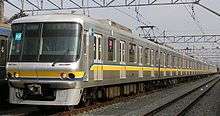Tokyo Metro 07 series
| Tokyo Metro 07 series | |
|---|---|
|
Tōzai Line 07 series set at Fukagawa Depot, January 2007 | |
| In service | 1992–Present |
| Manufacturer | Nippon Sharyo |
| Number built | 60 vehicles (6 sets) |
| Number in service | 60 vehicles (6 sets) |
| Formation | 10 cars per trainset |
| Fleet numbers | 71-76 |
| Operator(s) | Tokyo Metro |
| Depot(s) | Fukagawa |
| Line(s) served | Tokyo Metro Tōzai Line |
| Specifications | |
| Car body construction | Aluminium |
| Car length |
20,070 mm (65 ft 10 in) (end cars) 20,000 mm (65 ft 7 in) (intermediate cars) |
| Doors | 4 pairs per side |
| Maximum speed | 100 km/h (60 mph) |
| Acceleration | 3.3 km/h/s |
| Deceleration | 3.5 km/h/s (5.0 km/h/s for emergency brake)[1] |
| Electric system(s) | 1,500 V DC |
| Current collection method | Overhead wire |
| Safety system(s) | ATS-P, CS-ATC, WS-ATC |
| Track gauge | 1,067 mm (3 ft 6 in) |
The Tokyo Metro 07 series (東京地下鉄07系 Tōkyō Chikatetsu 07-kei) is an electric multiple unit (EMU) train type operated by Tokyo Metro on the Tokyo Metro Tōzai Line in Tokyo, Japan.
Operations
Current
- Tokyo Metro Tōzai Line
- Tōyō Rapid Line between Nishi-Funabashi Station and Tōyō-Katsutadai Station
- JR Chūō-Sōbu Line between Nakano Station and Mitaka Station
- JR Chūō-Sōbu Line between Nishi-Funabashi Station and Tsudanuma Station (weekday mornings and evenings only)
Former

- Tokyo Metro Yurakucho Line between Wakōshi Station and Shin-Kiba Station (from 1992 until 2008)
- Tokyo Metro Chiyoda Line (Set 07-101, September - December 2008)[1]
Formation
The six 10-cars sets, numbered 71 to 76, are formed as shown below, with car 1 at the west (Nishi-Funabashi) end.[2]
| Car No. | 1 | 2 | 3 | 4 | 5 | 6 | 7 | 8 | 9 | 10 |
|---|---|---|---|---|---|---|---|---|---|---|
| Designation | CT1 | M1 | T' | M2 | Tc1 | Tc2 | M3 | T | M1 | CT2 |
| Numbering | 07 101 | 07 201 | 07 301 | 07 401 | 07 501 | 07 601 | 07 701 | 07 801 | 07 901 | 07 001 |
Cars 2, 4, 7, and 9 each have one lozenge-type pantograph.[2]
Interior
 Interior view of Tōzai Line set
Interior view of Tōzai Line set Interior view showing LED passenger information display above doorway
Interior view showing LED passenger information display above doorway
Driver's cab
The front ends have an emergency exit. Headlights and taillights are round. Sets are fitted with skirts. These were modified on sets transferred to the Tōzai Line.
The trains originally had a two-handle control system. Tōzai Line sets were modified with a single-handle (left-hand) system on transfer to the Tōzai Line. The Tōzai Line sets have a master controller which incorporates a deadman system which applies the brakes if the master controller is released by the driver.
History

The first sets (07-101 and 07-102) were introduced in 1992. Four more sets (07-103 to 07-106) were delivered in 1994. The six 10-car sets were initially all based on the Tokyo Metro Yūrakuchō Line, but between July 2006 and March 2007, four sets (07-103 to 07-106) were transferred to the Tokyo Metro Tōzai Line to replace ageing 5000 series trains, and were repainted into that line's color scheme with light blue waistline stripes.[1] The two remaining Yurakucho Line sets (07-101 and 07-102) were stored out-of-use from October 2007. Set 07-101 was subsequently repainted into the Tōzai Line colours at Shin-Kiba Works, and temporarily reallocated to the Tokyo Metro Chiyoda Line from September until December 2008.[1][3]
References
- 1 2 3 4 Shiina, Takayuki (February 2009). 東京地下鉄07系 転籍計画の概要 [Outline of Tokyo Metro 07 series reallocation plan]. Japan Railfan Magazine (in Japanese). Vol. 49 no. 574. Japan: Koyusha Co., Ltd. pp. 80–83.
- 1 2 私鉄車両編成表 2012 [Private Railway Rolling Stock Formations - 2012]. Japan: JRR. July 2012. p. 75. ISBN 978-4-330-29911-2.
- ↑ "東京メトロ07-101編成、東西線色で千代田線に" [Tokyo Metro 07-101 runs on Chiyoda Line in Tozai Line livery]. Japan Railfan Magazine. Japan: Kōyūsha. December 2008. p. 164.
External links
| Wikimedia Commons has media related to Tokyo Metro 07 series. |
- Tokyo Metro Tōzai Line 07 series information (Japanese)
